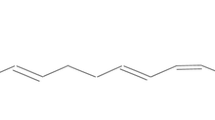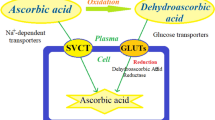Abstract
The aim of this study is to evaluate the protective effects of chrysophanol (CH) against paraquat (PQ)-induced pulmonary injury. Fifty BALB/C mice were randomized into five groups: (1) control, (2) PQ, (3) PQ + dexamethasone (Dex, 2 mg/kg), (4) PQ + CH (10 mg/kg), and (5) PQ + CH (20 mg/kg). A single dose of PQ (50 mg/kg, i.p.) was intraperitoneally given to induce acute lung injury. Then mice were treated with CH (10 and 20 mg/kg/day, orally) for 7 days. At the end of the experiment, animals were euthanized and then bronchoalveolar lavage fluid (BALF) and lung tissues were collected for histological observation, biochemical analysis, and Western blot analysis. Malondialdehyde (MDA), myeloperoxidase (MPO), superoxide dismutase (SOD), interleukin-6 (IL-6), IL-1β, and tumor necrosis factor-α (TNF-α) levels in BALF were determined. The levels of SOD and MDA in the lung were also detected. The peroxisome proliferator-activated receptor (PPAR)-γ and nuclear factor-kappaB (NF-κB) pathway proteins in the lung were determined by Western blot. Histological examination indicated that CH attenuated lung inflammation caused by PQ. Biochemical results showed that CH treatment significantly reduced the levels of MDA, MPO, and inflammatory cytokines and increased the level of SOD, compared to those in the PQ group. Meanwhile, Western Blot results revealed that CH increased PPAR-γ expression and inhibited NF-κB pathway activation after PQ challenge. These findings suggested the potential therapeutic effects of CH which is derived from a natural product on PQ-induced pulmonary injury.






Similar content being viewed by others
References
Silva, R., H. Carmo, V. Vilas-Boas, D.J. Barbosa, M. Monteiro, P.G. de Pinho, et al. 2014. Several transport systems contribute to the intestinal uptake of paraquat, modulating its cytotoxic effects. Toxicology Letters 232: 271–283.
Choi, J.S., S.S. Jou, M.H. Oh, Y.H. Kim, M.J. Park, H.W. Gil, et al. 2013. The dose of cyclophosphamide for treating paraquat-induced rat lung injury. The Korean Journal of Internal Medicine 28: 420–427.
Nguyen, V., D.S. Malik, and M.A. Howland. 2014. Methylene blue protects against paraquat-induced acute lung injury in rats. International Immunopharmacology 20: 358.
Chen, T., Y. Mou, J. Tan, L. Wei, Y. Qiao, T. Wei, et al. 2015. The protective effect of CDDO-Me on lipopolysaccharide-induced acute lung injury in mice. International Immunopharmacology 25: 55–64.
Lucas, R., A.D. Verin, S.M. Black, and J.D. Catravas. 2009. Regulators of endothelial and epithelial barrier integrity and function in acute lung injury. Biochemical Pharmacology 77: 1763–1772.
Lin, M.H., M.C. Chen, T.H. Chen, H.Y. Chang, and T.C. Chou. 2015. Magnolol ameliorates lipopolysaccharide-induced acute lung injury in rats through PPAR-gamma-dependent inhibition of NF-kB activation. International Immunopharmacology 28: 270–278.
Wei, D., and Z. Huang. 2014. Anti-inflammatory effects of triptolide in LPS-induced acute lung injury in mice. Inflammation 37: 1307–1316.
Chang, X., F. Luo, W. Jiang, L. Zhu, J. Gao, H. He, et al. 2015. Protective activity of salidroside against ethanol-induced gastric ulcer via the MAPK/NF-kappaB pathway in vivo and in vitro. International Immunopharmacology 28: 604–615.
Zhu, L., T. Chen, X. Chang, R. Zhou, F. Luo, J. Liu, et al. 2016. Salidroside ameliorates arthritis-induced brain cognition deficits by regulating Rho/ROCK/NF-κB pathway. Neuropharmacology 103: 134–142.
Chen, T., Q. Guo, H. Wang, H. Zhang, C. Wang, P. Zhang, et al. 2015. Effects of esculetin on lipopolysaccharide (LPS)-induced acute lung injury via regulation of RhoA/Rho kinase/NF-small ka, CyrillicB pathways in vivo and in vitro. Free Radical Research 49: 1459–1468.
Chen, T., J. Gao, P. Xiang, Y. Chen, J. Ji, P. Xie, et al. 2015. Protective effect of platycodin D on liver injury in alloxan-induced diabetic mice via regulation of Treg/Th17 balance. International Immunopharmacology 26: 338–348.
Chen, T., L. Xiao, L. Zhu, S. Ma, T. Yan, and H. Ji. 2015. Anti-asthmatic effects of ginsenoside Rb1 in a mouse model of allergic asthma through relegating Th1/Th2. Inflammation 38: 1814–1822.
Lin, F., C. Zhang, X. Chen, E. Song, S. Sun, M. Chen, et al. 2015. Chrysophanol affords neuroprotection against microglial activation and free radical-mediated oxidative damage in BV2 murine microglia. International Journal of Clinical and Experimental Medicine 8: 3447–3455.
Lee, M.S., and C.B. Sohn. 2008. Anti-diabetic properties of chrysophanol and its glucoside from rhubarb rhizome. Biological & Pharmaceutical Bulletin 31: 2154–2157.
Zhang, K., J. Liu, X. You, P. Kong, Y. Song, L. Cao, et al. 2016. P2X7 as a new target for chrysophanol to treat lipopolysaccharide-induced depression in mice. Neuroscience Letters 613: 60–65.
Zhang, N., and X. Zhang. 2014. Chrysophanol inhibits NALP3 inflammasome activation and ameliorates cerebral ischemia/reperfusion in mice. 2014:370530.
Rim, H.K., P.D. Moon, I.H. Choi, E.H. Lee, H.M. Kim, and H.J. Jeong. 2013. SoSoSo or its active ingredient chrysophanol regulates production of inflammatory cytokines & adipokine in both macrophages & adipocytes. The Indian Journal of Medical Research 137: 142–150.
Orito, K., Y. Suzuki, H. Matsuda, M. Shirai, and F. Akahori. 2004. Chymase is activated in the pulmonary inflammation and fibrosis induced by paraquat in hamsters. The Tohoku Journal of Experimental Medicine 203: 287–294.
Ahmed, A.A. 2009. Protective effect of montelukast on paraquat-induced lung toxicity in rats. Bioscience Trends 3: 63–72.
Jiang, W., F. Luo, Q. Lu, J. Liu, P. Li, X. Wang, et al. 2016. The protective effect of Trillin LPS-induced acute lung injury by the regulations of inflammation and oxidative state. Chemico-Biological Interactions 243: 127–134.
Xie, X., S. Sun, W. Zhong, L.W. Soromou, X. Zhou, M. Wei, et al. 2014. Zingerone attenuates lipopolysaccharide-induced acute lung injury in mice. International Immunopharmacology 19: 103–109.
Chen, T., Ma, Z., Zhu, L., Jiang, W., Wei, T., Zhou, R., et al. 2015. Suppressing receptor-interacting protein 140: a new sight for salidroside to treat cerebral ischemia. Molecular Neurobiology.
Huang, X., Y. Liu, Y. Lu, and C. Ma. 2015. Anti-inflammatory effects of eugenol on lipopolysaccharide-induced inflammatory reaction in acute lung injury via regulating inflammation and redox status. International Immunopharmacology 26: 265–271.
Tianzhu, Z., Y. Shihai, and D. Juan. 2014. The effects of morin on lipopolysaccharide-induced acute lung injury by suppressing the lung NLRP3 inflammasome. Inflammation 37: 1976–1983.
Bettelli, E., Y. Carrier, W. Gao, T. Korn, T.B. Strom, M. Oukka, et al. 2006. Reciprocal developmental pathways for the generation of pathogenic effector TH17 and regulatory T cells. Nature 441: 235–238.
Tianzhu, Z., and W. Shumin. 2015. Esculin inhibits the inflammation of LPS-induced acute lung injury in mice via regulation of TLR/NF-kappaB pathways. Inflammation 38: 1529–1536.
Wang, J., Y.T. Liu, L. Xiao, L. Zhu, Q. Wang, and T. Yan. 2014. Anti-inflammatory effects of apigenin in lipopolysaccharide-induced inflammatory in acute lung injury by suppressing COX-2 and NF-kB pathway. Inflammation 37: 2085–2090.
Gao, J., H. He, W. Jiang, X. Chang, L. Zhu, F. Luo, et al. 2015. Salidroside ameliorates cognitive impairment in a d-galactose-induced rat model of Alzheimer’s disease. Behavioural Brain Research 293: 27–33.
He, H., X. Chang, J. Gao, L. Zhu, M. Miao, and T. Yan. 2015. Salidroside mitigates sepsis-induced myocarditis in rats by regulating IGF-1/PI3K/Akt/GSK-3beta signaling. Inflammation 38: 2178–2184.
Ma, C.H., J.P. Liu, R. Qu, and S.P. Ma. 2014. Tectorigenin inhibits the inflammation of LPS-induced acute lung injury in mice. Chinese Journal of Natural Medicines 12: 841–846.
Tao, W., Q. Su, H. Wang, S. Guo, Y. Chen, J. Duan, et al. 2015. Platycodin D attenuates acute lung injury by suppressing apoptosis and inflammation in vivo and in vitro. International Immunopharmacology 27: 138–147.
Ma, C., L. Zhu, J. Wang, H. He, X. Chang, J. Gao, et al. 2015. Anti-inflammatory effects of water extract of Taraxacum mongolicum hand.-Mazz on lipopolysaccharide-induced inflammation in acute lung injury by suppressing PI3K/Akt/mTOR signaling pathway. Journal of Ethnopharmacology 168: 349–355.
Chang, X., H. He, L. Zhu, J. Gao, T. Wei, Z. Ma, et al. 2015. Protective effect of apigenin on Freund’s complete adjuvant-induced arthritis in rats via inhibiting P2X7/NF-kappaB pathway. Chemico-Biological Interactions 236: 41–46.
Chen, T., Wang, R., Jiang, W., Wang, H., Xu, A., Lu, G., et al. 2015. Protective effect of astragaloside IV against paraquat-induced lung injury in mice by suppressing Rho signaling. Inflammation.
Zhu, L., T. Wei, X. Chang, H. He, J. Gao, Z. Wen, et al. 2015. Effects of salidroside on myocardial injury in vivo in vitro via regulation of Nox/NF-kappaB/AP1 pathway. Inflammation 38: 1589–1598.
Kim, S.J., M.C. Kim, B.J. Lee, D.H. Park, S.H. Hong, and J.Y. Um. 2010. Anti-inflammatory activity of chrysophanol through the suppression of NF-kappaB/caspase-1 activation in vitro and in vivo. Molecules (Basel, Switzerland) 15: 6436–6451.
Acknowledgments
This study was supported by grants of the Natural Science Foundation of Jiangsu Province of China (BK20150707) and the Fundamental Research Funds for the Central Universities (JKZD2013009 and ZJ15030). This project also funded by the Priority Academic Program Development of Jiangsu Higher Education Institutions (PAPD), Research Innovation Program Project for Graduate Students in Jiangsu Province (CXZZ13_03), and National Undergraduate Training Programs for Innovation and Entrepreneurship (G13034).
Author information
Authors and Affiliations
Corresponding author
Ethics declarations
Conflict of Interest
The authors declare that they have no conflict of interest.
Rights and permissions
About this article
Cite this article
Li, A., Liu, Y., Zhai, L. et al. Activating Peroxisome Proliferator-Activated Receptors (PPARs): a New Sight for Chrysophanol to Treat Paraquat-Induced Lung Injury. Inflammation 39, 928–937 (2016). https://doi.org/10.1007/s10753-016-0326-2
Published:
Issue Date:
DOI: https://doi.org/10.1007/s10753-016-0326-2




